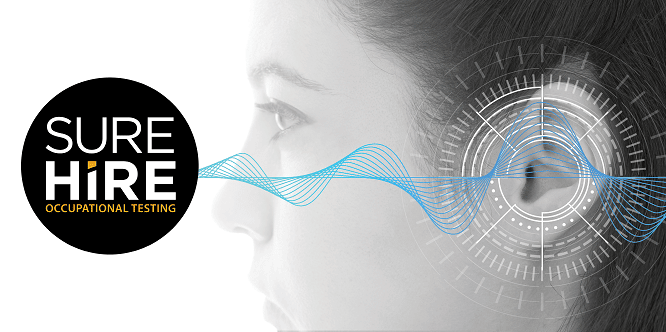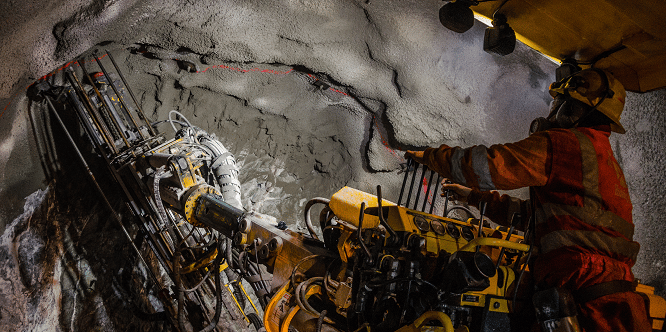TAKEAWAY: Mining is one of the most at-risk industries for noise-induced hearing loss (NIHL), a preventable yet widespread problem. Read on to learn about noise risks in the mining industry and how you can take proactive steps toward risk prevention.
Jump Ahead
Mining is one of the most at-risk industries for noise-induced hearing loss (NIHL), a preventable yet widespread problem. Employers must understand the risks and take steps to reduce the incidence of NIHL to help keep their workers safe.
NIHL occurs when a person is exposed to sounds loud enough to cause hearing loss. It may happen after a single loud sound or through exposure over time. The resulting damage causes permanent and irreversible hearing loss.

Book an Appointment Today!
SureHire’s audiometric testing services allow you to detect NIHL before it becomes a problem, providing you with the information you need for investigation and intervention so you can protect your workforce.
This article is the second in a five-part series on NIHL in various high-risk industries. Read on to learn about noise risks in the mining industry and how employers can minimize NIHL risks.
Noise risks in the mining industry
Noise is the primary cause of preventable hearing loss, and although overall noise exposure in mines has decreased over time, it remains a very high-risk sector. Data from 1999-2004 identified that the mining sector had a higher prevalence of hazardous workplace noise exposure than any other industry.
Exposure to sounds of 80dB or above can cause NIHL. The louder the sound, the greater the risk. Studies have found that the majority of miners are exposed to hazardous noise levels, most exceeding 85dB of eight-hour equivalent continuous exposure and some at the peak exposure standard of 140dB.
The mining industry exposes workers to several loud noises, including the following:
- The pneumatic percussion drill presents the most significant noise-related mining hazard
- Continuous and impact noise from extractive equipment, namely continuous miners and long-wall shearers
- Ancillary noise from fans and blowers used for mine ventilation
- Engine, transmission, exhaust, and vibration noises from loaders, haul trucks, and man-carrying haulage equipment
Mining is complex, and hazardous noise exposure levels can come from various processes, including blasting, drilling, cutting, crushing, conveying, material handling, and ore processing. Workers in underground coal mines and coal preparation plants are among the most at-risk for hazardous noise exposure.
How mining industry employers can minimize the risk of NIHL in the workplace
Mining employers can help prevent hearing loss and avoid further damage to already-affected workers. The following suggestions will help employers tackle NIHL in the workplace.
Understand the risks and impact of NIHL, and your obligations
Employers must first understand the risks of NIHL in the workplace so they can take action to reduce or eliminate the risks. Noise exposure also occurs outside the workplace, increasing NIHL risks, so employers should take every step possible to lessen workplace exposure.
It’s also crucial to understand the impact of NIHL on workers and organizations. Communication can become difficult for hard-of-hearing employees, and they may experience tinnitus and other related problems. Hearing loss can impact job performance, impede employee career progression in hearing-critical roles, and adversely affect a worker’s quality of life.
Noise exposure standards and regulations protect most workers in the developed world. For example, the Mine Safety and Health Administration (MSHA), part of the United States Department of Labor, sets noise exposure limits for mine workers.
The CDC noise rule for miners states that permissible occupational noise exposure should not exceed an 8-hour time-weighted average (TWA8) of 90 dB(A). Employers should stay up-to-date on requirements as they may change over time.
Canadian mining employers can refer to the Mining Association of Canada, the National voice of the Canadian mining industry. It’s also crucial to stay current with provincial and federal laws on noise exposure limits.
Audiometric questionnaires
Employers can understand worker noise exposure using a standard audiometric questionnaire to help determine lifetime noise exposure from work and leisure. It’s crucial to recognize that noise risks will vary between employees based on several factors, such as exposure levels, age, health status, and individual variability.
Invest in noise-reducing equipment
Mining industry employers can invest in modern equipment and technology with a quieter design to reduce worker risk. Examples include:
- Partial cabs between the operator and drill steel on surface-drilling rigs to lower the sound level at the operator station
- Coated flight bars on continuous miners have been shown to reduce sound levels by 5-7dB in a laboratory setting
- Jacketed tail rollers can further reduce the noise of continuous miners
- Dust collector designs can help reduce fan noise
- The combination of a bit isolator and a drill chuck isolator will reduce noise exposure for roof bolting machine operators.
- Structural modifications for longwall cutting drums can reduce noise from longwall shearers.
Mining sector equipment should be well-maintained and replaced when worn, and employers must train employees to use it properly.
Personal protective equipment (PPE) for mining employees
Hearing protection devices such as earmuffs and custom-molded earplugs can help protect mining employees from hazardous noise. Employers should understand how to choose the right type of hearing protection for employees.

Order Custom-Moulded Earplugs
Our custom moulded earplugs are made of medical-grade silicone that is soft and durable enough to last 5 years or more with proper care. With a variety of styles to choose from, that can be customized to ensure appropriate attenuation, you can feel confident knowing your employees will be safe, healthy, and productive on the job.
It’s also vital that employees comply with usage recommendations for hearing protection devices. Employee education on the importance of using hearing protection devices and getting the right fit for the individual are important considerations here. Misuse is common in the mining sector and can render hearing protection ineffective.
Baseline and periodic hearing tests
Employers in high-risk industries for NIHL should review their health and safety programs to ensure they have solid preventative measures to protect employees. Audiometric testing is a vital and often mandatory tool for NIHL prevention and early detection.
Audiometric testing evaluates a person’s ability to hear sounds of various intensities and pitches, thereby identifying normal or impaired hearing. The results enable employers to take actions that will help protect their employees from any further damage. Employers should arrange baseline and periodic hearing tests and can opt for convenient on-site testing to save time.

Book an Appointment Today!
SureHire’s audiometric testing services allow you to detect NIHL before it becomes a problem, providing you with the information you need for investigation and intervention so you can protect your workforce.
NIHL in the mining industry | In conclusion
The mining industry poses exceptionally high risks of NIHL for workers, yet NIHL is preventable. The NIOSH mining program is addressing the issue of NIHL through its research program, and employers can also take several steps to mitigate risks.
Actions for mining employers can be as simple as helping employees avoid exposure to loud sounds wherever possible or reducing exposure time and frequency if avoidance is impossible.
Modern, well-maintained noise-reducing equipment, appropriate personal protective equipment, and audiometric testing are three main areas employers can focus on to help their employees avoid NIHL or prevent further damage.
For further related reading, find out about NIHL in the oil and gas industry. Mining industry employers may also want to discover how to reduce musculoskeletal injuries in mine workers.
You May Also Be Interested In…
- Do You Have Reasonable Suspicion?
 Employers cannot initiate reasonable suspicion testing without first going through the 5-step process. Reasonable suspicion training provides critical information about how to initiate reasonable suspicion testing, including the 5-step process and other tools that employers can use to help manage the misuse of alcohol and drugs in the workplace.
Employers cannot initiate reasonable suspicion testing without first going through the 5-step process. Reasonable suspicion training provides critical information about how to initiate reasonable suspicion testing, including the 5-step process and other tools that employers can use to help manage the misuse of alcohol and drugs in the workplace. - An Employer’s Guide: What You and Your Employees Need to Know About DOT Drug & Alcohol Testing
 When implementing or maintaining DOT Drug & Alcohol testing, there are key areas that employers should consider.
When implementing or maintaining DOT Drug & Alcohol testing, there are key areas that employers should consider. - SureHire Occupational Testing Acquires COHR Health: A Positive Step Towards Safe, Healthy, Productive Workforces and Communities
 We are thrilled to announce that today, May 6, 2024, SureHire Occupational Testing has officially acquired COHR Health, a well-known leader in occupational health services. Read on…
We are thrilled to announce that today, May 6, 2024, SureHire Occupational Testing has officially acquired COHR Health, a well-known leader in occupational health services. Read on… - Occupational Testing Use Case – Mining
 In this case study, we will explore how mining companies can use various types of occupational tests to reduce Total Recordable Incident Rates (TRIR) long term.
In this case study, we will explore how mining companies can use various types of occupational tests to reduce Total Recordable Incident Rates (TRIR) long term. - 9 Strategies to Keep Workers Cool on Drilling Sites During Hot Summer Months
 This article delves into strategies to keep workers cool and safe on drilling sites during the hot summer months.
This article delves into strategies to keep workers cool and safe on drilling sites during the hot summer months. - Hearing Conservation Basics: How to Manage Occupational Noise
 Learn how to proactively mitigate occupational noise risks and help prevent NIHL among workers.
Learn how to proactively mitigate occupational noise risks and help prevent NIHL among workers.

